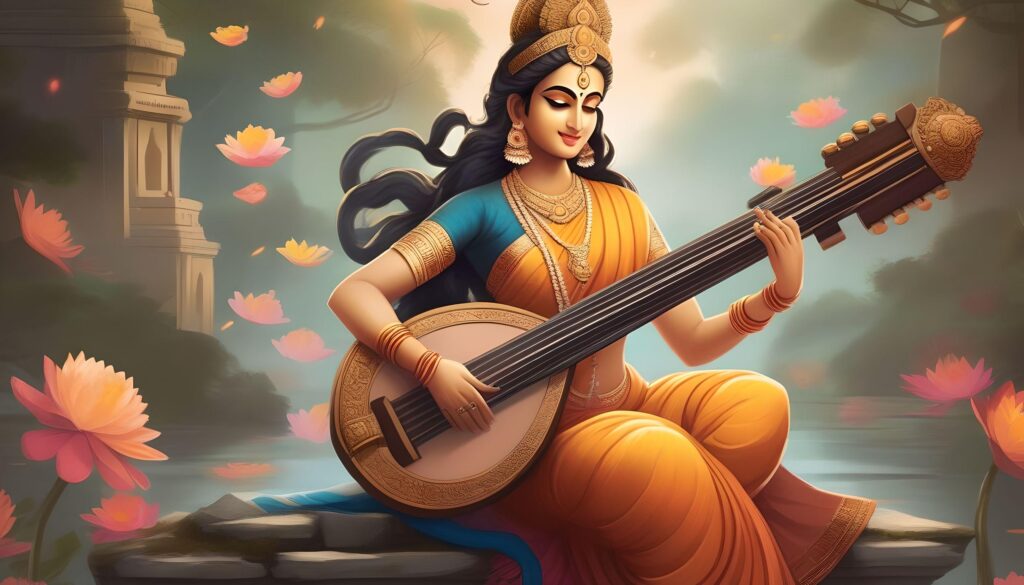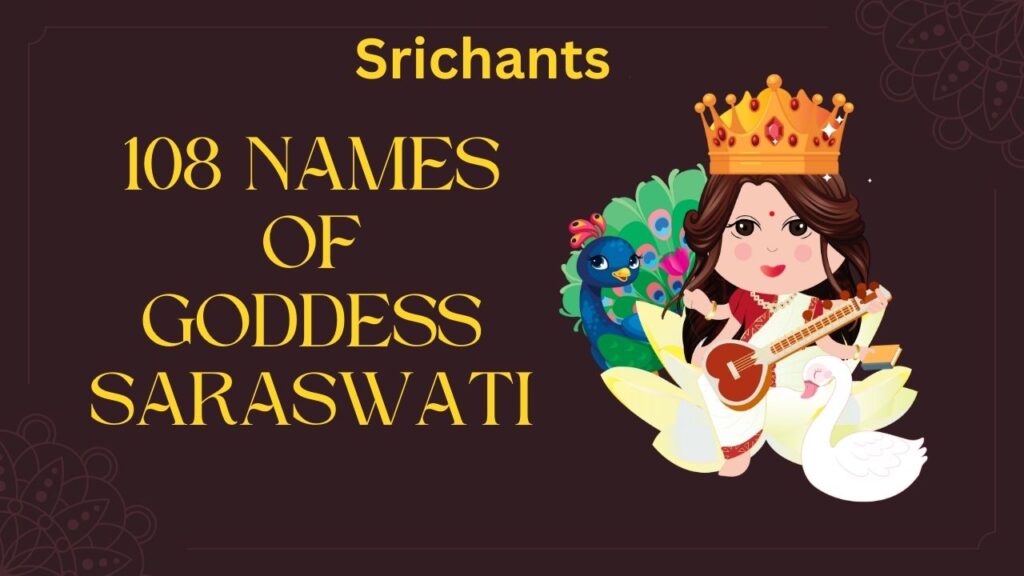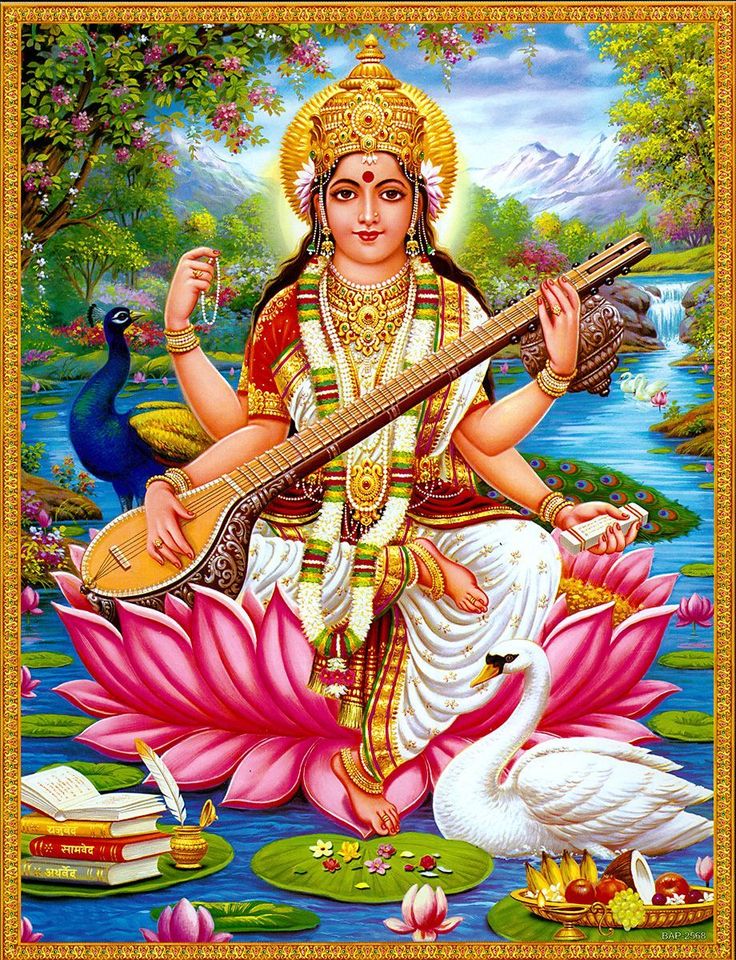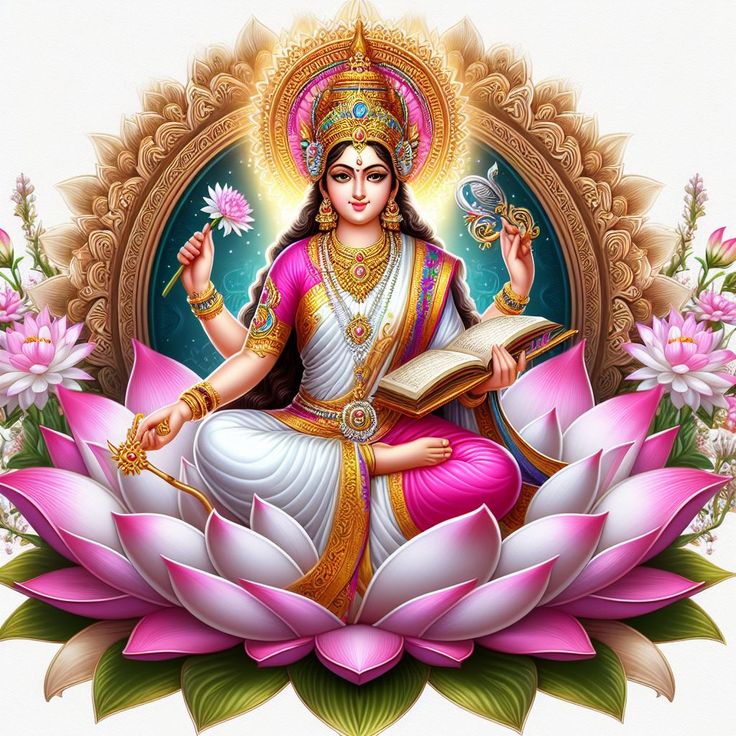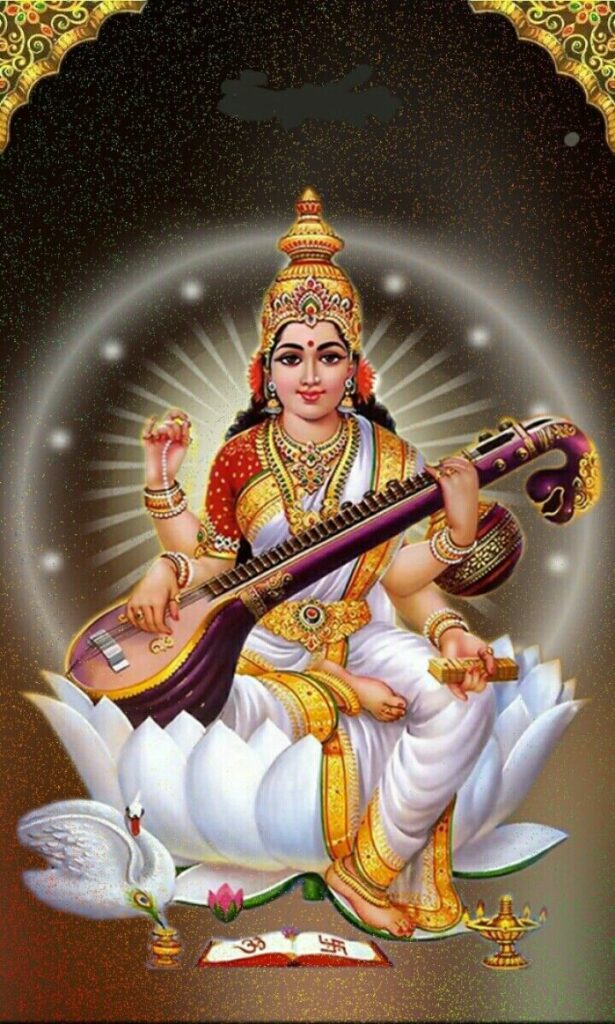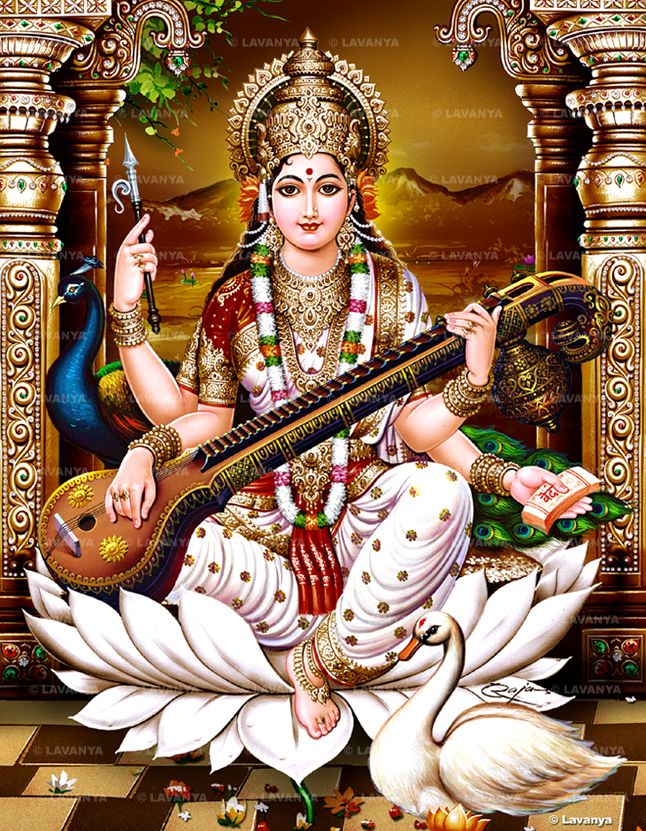Saraswati History Of Indian Art : Role Of Saraswati
Introduction
The old Indian faith, Hinduism, is a tapestry of many gods, each reflecting a different aspect of the divine. Among this pantheon, the goddess Saraswati is particularly shining in terms of knowledge, creativity, and wisdom and the search of truth. Her mesmerizing presence has cut past the bounds of religion, into the domains of art, literature, and cultural traditions all around the Indian subcontinent and beyond.
Saraswati’s Origins and Mythological Interpretation
Saraswati’s name has etymology that reveals her multifarious character. Derived from the Sanskrit words “saras” meaning “water” or “flow,” and “wati,” suggesting “possession,” Saraswati personifies the ceaseless flow of knowledge, wisdom, and creative expression. Her connection with the famous sacred river Saraswati, which was regarded in ancient Vedic writings as the primordial source of wisdom, adds even more meaning.
Hindu mythology regards Saraswati’s beginnings as veiled in fascinating stories. One well-known story relates how she came out of the mouth of Lord Brahma, the universe’s creator, during creation. This symbolic birth emphasizes her personal relationship with the divine spark igniting human consciousness and the source of knowledge. Saraswati is also shown in another story as Brahma’s consort; their marriage represents the harmonic fusion of intellectual and creative energies preserving the cosmic equilibrium.
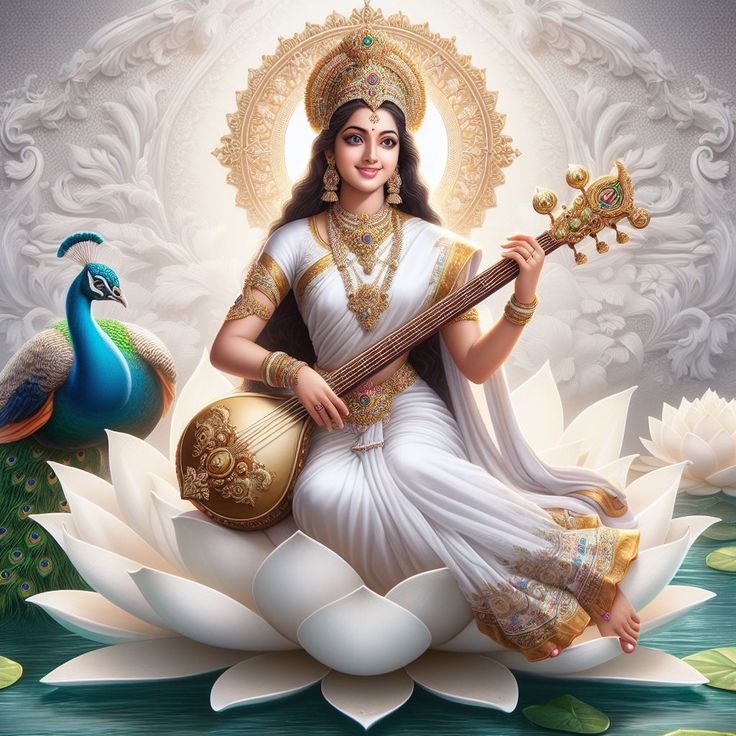
In the Hindu Pantheon, Saraswati
Saraswati’s importance in the Hindu pantheon is enhanced yet more by her connection with the holy triad sometimes known as the Tridevi. Saraswati forms the trio of feminine force that leads and nurtures the spiritual and material spheres of life alongside the goddesses Lakshmi, who stands for money and success, and Parvati, the personification of strength and dedication.
Fascinating also is Saraswati’s interaction with the male gods in the Hindu pantheon. Often shown as enthralled by her divine beauty, her lover, Lord Brahma, emphasizes the goddess’s capacity to transcend the earthly and enthrall the divine with her intellectual and artistic genius.
The Multiple Symbolism of Saraswati
Saraswati’s emblematic symbolism and images abound in their complexity and meaning. Often shown seated on a lotus flower, she has four limbs, each with a unique quality that reflects a different aspect of her heavenly character. Usually shown as palm leaves or scrolls, the holy writings mark the storehouse of heavenly wisdom and the Vedas’ timeless lessons. The rosary stands for the transforming power of loyalty and the ongoing search of spiritual truth. Representing the harmonic resonance of the world and the rhythmic flow of creative expression, the veena is a stringed musical instrument.
One especially strong emblem is the swan, Saraswati’s vahana or horse. Thought to be able to separate milk from water, the swan represents Saraswati’s function as the distributor of actual knowledge among the great sea of ignorance. Her white clothing, which stands for transcendence and purity, accentuates her celestial nature even more.
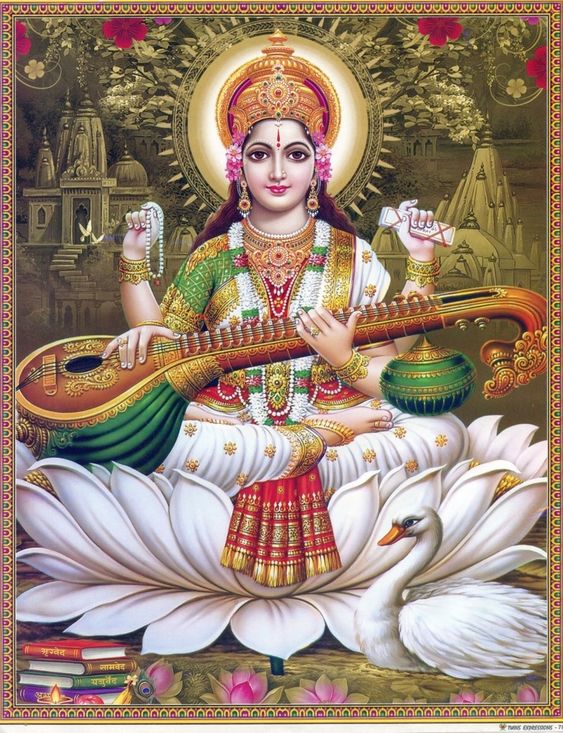
Hindu Literary and Artistic Saraswati
As pervasive as it is deep, Saraswati’s presence throughout Hindu literature and art is Hindu philosophy is built on the ancient scriptures known as the Vedas, which abound in hymns and songs praising her virtues and calling her blessings. She appears as a river in the Mahabharata to assist the sage Vyasa in writing the epic, while in the epic Ramayana the sage Valmiki calls her to empower Lord Rama with heavenly wisdom and ability.
Saraswati’s celestial expression has also found canvas in the fine arts. Showcasing the creative brilliance of the Indian subcontinent, delicate sculptures, paintings, and reliefs honoring the goddess adorn temples and holy sites all around. From the brilliant Tanjore paintings of South India to the energetic Madhubani art of the north, Saraswati’s iconography has been a continual inspiration for next generations of painters.
Saraswati’s Global Authority
Respect for Saraswati transcends India’s boundaries; her influence permeates the religious and cultural settings of surrounding nations. She is recognized in Burma (Myanmar) as Thurathadi; in Japan, she is Benzaiten, the goddess of eloquence, music, and the humanities. These cross-cultural expressions of the goddess attest to the worldwide attraction of her divine qualities and the interdependence of the Hindu and Buddhist traditions.
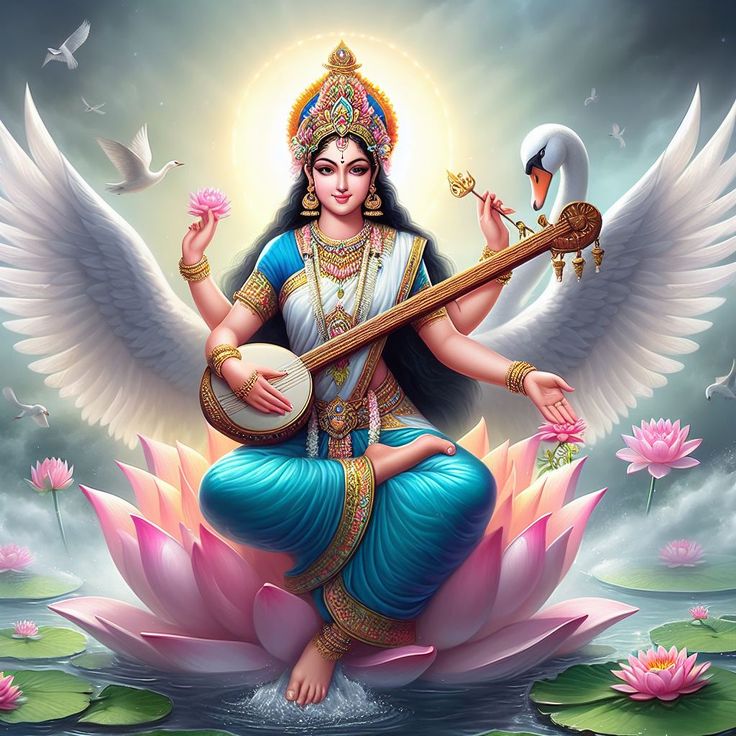
Saraswati in Celebrations and Festivals
Particularly among students, academics, and artists, the devotion to Saraswati permeates the fabric of Hindu religious practice. Celebrated in the spring, the annual Saraswati Puja—also known as Vasant Panchami—is a joyful celebration honoring the goddess’s gifts for scholastic excellence and artistic inspiration. Seeking her direction in their search of knowledge and wisdom, devotees present prayers, flowers, and sweets to Saraswati’s idols.
Beyond these official ceremonies, Saraswati’s presence permeates Hindu daily life. Considered as representations of the goddess herself, the respect for books and knowledge is evidence of her continuing impact. Whether intellectual, creative, or entrepreneurial, the calling of Saraswati’s name at the start of any new project emphasizes the conviction in her heavenly graces.

Saraswati and the Search for Information
Being the goddess of knowledge, intelligence, and education makes Saraswati highly adored. Students, academics, and intellectuals looking for divine direction in their work regularly call on her. Often chanted at the beginning of Vedic courses and educational activities, the Saraswati Vandana is a holy chant honoring the goddess that gives them spiritual relevance.
Saraswati’s role as the patroness of knowledge and the guardian of the holy teachings is strengthened even more by her affiliation with the Vedas, the ancient books that underlie Hindu doctrine. Her melodic veena helps her to enthrall the celestial beings, notably the Gandharvas, the divine musicians of the heavens, so highlighting her function as the inspiration for the arts and the vehicle of creative expression.
The Fierce Aspects of Saraswati
Hindu mythology notes Saraswati’s ferocious sides even though she is typically shown as a calm and elegant goddess. As Mahavidya Nila Saraswati, the Blue Saraswati, she personifies the transforming ability of knowledge and the annihilation of ignorance. Riding a blue horse and brandishing weapons, this avatar of the goddess symbolizes her capacity to subdue the powers of evil and illusion that thwart the path of enlightenment.
Saraswati’s dual nature—that of the gentle and the strong—reflects the duality of the search for knowledge. The goddess reminds us that real wisdom sometimes calls for the bravery to face and pass through the challenges impeding human and spiritual development.
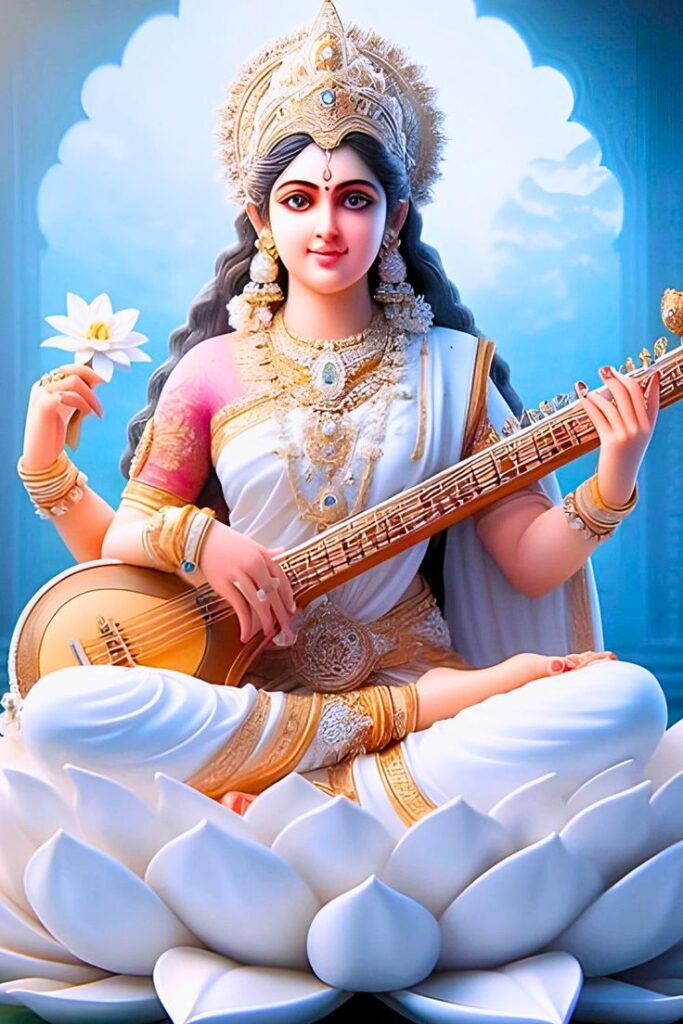
The Resilience of Saraswati’s Legacy
Saraswati’s eternal appeal shown in Indian art and culture is evidence of her ongoing legacy. From the old Vedic hymns to the contemporary respect for her presence in educational institutions, the goddess’s impact has cut over religious lines and historical bounds.
Saraswati enthralls the hearts and brains of researchers, artists, and devotees alike as the embodiment of wisdom, creativity, and the harmonic flow of the world. In the tapestry of Hindu mythology and cultural customs, her capacity to inspire and encourage the search of learning, while also reflecting the transforming force of enlightenment, makes her a renowned and beloved character.
Conclusion
In the rich fabric of Indian art and culture, the goddess Saraswati is a lighthouse of knowledge, wisdom, and creativity—the constant search for truth. For millennia both artists and followers have been enthralled with her multifarious symbolism, which spans the flow of water, the harmony of music, and the purity of the lotus.
We are reminded of the ongoing relevance of the search of knowledge, the development of the arts, and the cultivation of the spirit as we keep valuing Saraswati’s holy essence. May the blessings of the goddess inspire and guide us on our road of personal and spiritual development, therefore enabling us to welcome the duality of wisdom and transformation she so elegantly embodies.
#saraswati #history #indian #art #cultural

